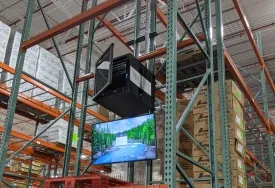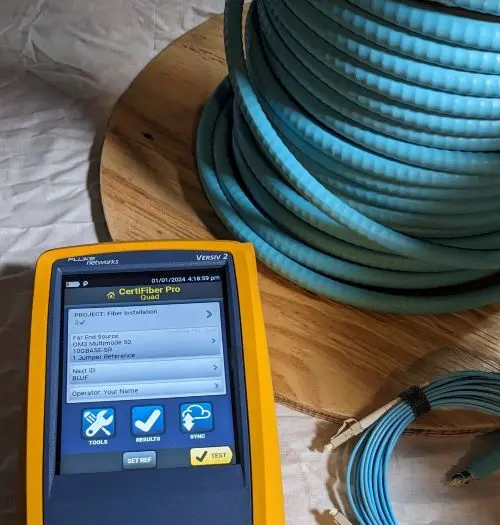Farmington Hills, MI
Video surveillance system cabling design

Designing a video surveillance system's cabling infrastructure is a critical component of ensuring the system's effectiveness and reliability. A well-planned cabling design not only supports current technological needs but also accommodates future expansions and enhancements. At its core, the cabling design should focus on minimizing signal loss, reducing interference, and ensuring adequate power delivery to all components. When embarking on a video surveillance project, one must consider the types of cables used—whether coaxial for traditional analog systems or Ethernet for modern IP-based systems. The latter, often relying on Power over Ethernet (PoE), can significantly streamline installation by reducing the need for separate power cables. Proper cabling not only enhances the overall performance of the surveillance system but also significantly reduces maintenance costs and downtime.
In addition to choosing the right type of cables, a robust video surveillance system cabling design must consider the layout and routing of these cables. This involves meticulous planning to avoid electromagnetic interference, which can degrade video quality and performance. For instance, cables should be routed away from sources of interference such as electrical wiring and large metal objects. Furthermore, proper labeling and documentation of the cabling infrastructure are crucial for maintenance and troubleshooting. Adhering to industry standards, such as those set by the Electronic Industry Alliance (EIA) and the Telecommunications Industry Association (TIA), is essential to ensure the system meets safety and performance benchmarks. These standards provide guidelines on cable spacing, grounding, and protection, which are vital for a reliable and efficient surveillance system.
Future-proofing is another crucial aspect of video surveillance system cabling design. As technology rapidly evolves, surveillance systems must be adaptable to accommodate new advancements without requiring a complete overhaul. Implementing a structured cabling system offers the flexibility needed to integrate new technologies, such as higher resolution cameras or advanced analytics software, with minimal disruption. This approach also allows for scalability, enabling system expansion as security needs grow. Additionally, incorporating fiber optic cables can enhance data transmission speed and distance capabilities, catering to larger installations with multiple camera locations. In summary, a well-conceived cabling design not only lays the foundation for an effective video surveillance system but also enhances its longevity and adaptability, ensuring it meets both current and future security demands.
We bring a high level of expertise to every project, backed by years of industry experience. Please visit our work to see detailed examples of our completed projects and the high-quality standards we uphold.

Our team stays up-to-date with the latest network standards and installation practices, ensuring that your systems are cutting-edge and compliant. This means we use the most current technologies and methods to deliver reliable, efficient, and future-proof networking solutions.

We use only the highest quality copper, fiber, and AV products, ensuring superior performance and durability in all our installations. Each product is certified to meet or exceed manufacturers' specifications, guaranteeing optimal reliability and efficiency for your network.

Our data cabling projects are performed professionally, reliably, and with full accountability, giving you peace of mind and confidence in our services.
Upgraded a global financial services company’s WAN to an AT&T rate adjustable 100Mbps interstate-rated switched Ethernet circuit. Install flexible conduit from the parking garage telco room to the building interior. Pull 300’ CAT 5E CMP cable from AT&T demarc using the building’s existing conduit over the lobby and up to the tenant’s 3rd floor MDF...
Complete build-out of the cable plant for a national fine dining restaurant. Install flame-retardant telecom backboards in the electrical room. Install an 11U wall-mount open swing rack on the backboard. Ground rack to building UFER with #6 AWG. Core drill into the masonry block wall and install 1-¼ EMT sleeves. Build overhead cable support system in kitchen and dining...
Achieve higher bandwidth and faster data transfer rates for an investment bank branch’s Main Distribution Frame (MDF) to Immediate Distribution Frame (IDF) backbone. Pull (1) 6-strand armored fiber, 50 MIC MM OM4 cable and (4) CAT 6 CMP cables from 1st floor MDF to 1st floor IDF using existing cable pathways. Ground armored fiber to building UFER. Terminate, certify, and label all...
Complete network build-out of the appliances & kitchen cabinets department for a national home improvement retailer. Label existing data and voice cabling that connects to existing store terminals, printers, and phones. Reroute existing cabling to a temporary location. Move store terminals, printers, and phones to...

Farmington Hills, Michigan, is a vibrant and dynamic city located in Oakland County, just northwest of Detroit. With a population of approximately 81,000 residents, Farmington Hills is recognized as one of the largest and most affluent cities in the state. This thriving community offers a perfect blend of suburban tranquility and urban convenience, making it an ideal place for families, businesses, and visitors alike.
One of the unique features of Farmington Hills is its commitment to maintaining a high quality of life. The city boasts a wealth of green spaces, with Heritage Park being a standout attraction. Spanning 211 acres, this park offers a serene escape with its nature trails, picnic areas, and a beautiful amphitheater that hosts numerous community events and concerts. The Farmington Hills Nature Center, located within the park, provides educational programs and interactive exhibits that engage visitors of all ages.
Culturally, Farmington Hills is a hub of activity, with the Farmington Hills Community Library serving as a cornerstone of educational and cultural enrichment. The library offers a wide array of resources and hosts various events, workshops, and lectures that cater to diverse interests. The city's rich cultural tapestry is further highlighted by the annual Greater Farmington Film Festival, which celebrates independent films and fosters community dialogue.
Economically, Farmington Hills is a powerhouse within the region, supported by a robust network of key industries including automotive, technology, and healthcare. The presence of major corporations such as Bosch, Nissan Technical Center North America, and Gale, a Cengage company, underscores the city’s role as a significant business hub. These industries not only provide ample employment opportunities but also contribute to the city’s economic vitality and innovation.
In terms of community dynamics, Farmington Hills is characterized by its excellent educational institutions, including the highly regarded Farmington Public Schools and several private schools that offer top-tier education. The city is also home to branches of Oakland Community College and Wayne State University, providing residents with access to higher education and professional development.
Historically, Farmington Hills has roots that date back to the early 19th century, with the Governor Warner Mansion serving as a testament to its rich past. This Victorian-style mansion, once home to Michigan’s 26th governor, remains open to the public, offering guided tours and a glimpse into the city’s storied history.
Geographically, Farmington Hills is strategically positioned with convenient access to major highways such as I-696 and M-5, making it an appealing location for commuters and businesses seeking connectivity to the greater Detroit metropolitan area. This